Wednesday, February 13, 2008
How much can your horse or mule pull?
It's only February and the first daffodils are blooming in Southern Pines, NC. Time to get mule Polly in shape for Part II of the Lost Sea Expedition. That's the wagon journey we're taking from Canada to Mexico to learn more about the inland sea that covered the Great Plains 80 million years ago. (In Part I, we spent 6 months in 2007 traveling from Canada to South Dakota).
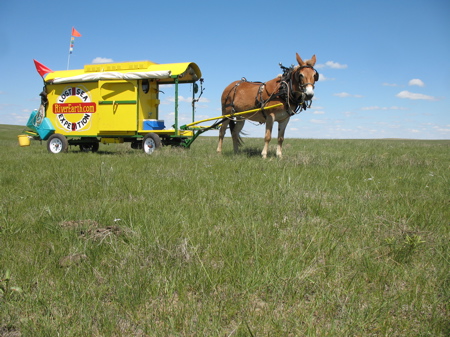
Mule Polly and the Lost Sea wagon on virgin prairie
North of Dagmar, Montana
Getting Polly legged up is really more about getting out with friends than getting her fit. Typically, three our four of us head out with our wagons and carts to visit a little-known corner of North Carolina - from bluegrass music at Ford's Bluegrass Mill in Rockingham (a mill converted to pickin' venue) to shark's teeth in Aurora.
Interesting is what a wide range of equines and vehicles gather for these informal outings. Here's a typical procession.
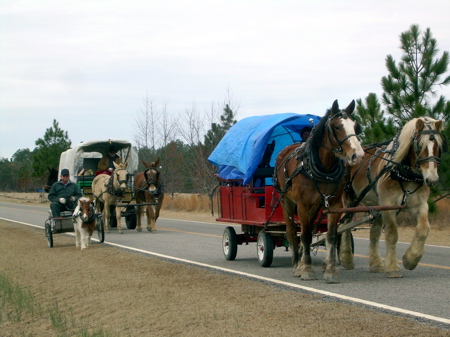
Vic's miniature (L) keeps up with Kenny's draft team (R)
Outside Wagram, NC
From Vic's miniature horse that weighs 200 pounds to Ken's draft team that weighs 15 times as much, somehow, they all go the distance.
Which begs the question. How much can a horse (or mule) pull?
This question was not lost on the US Army which, in a 1917 manual wrote that, "an average draft mule can pull on a level 80 lbs. (traction) at 2.5 miles an hour for 10 hours every day, or, in other words, can pull 80 lbs. over 25 miles of average level roads every day." In real terms, this meant that a team of 4 draft mules, which weighed about 4,500 pounds, could pull a loaded Army wagon, which weighed around 4,500 pounds, 25 miles per day.
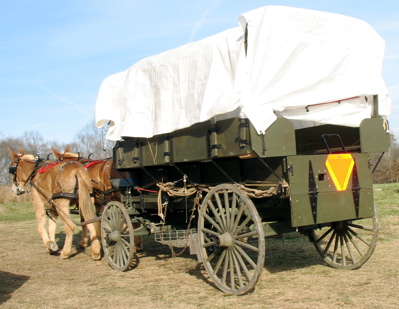
Ronald Hudson's Army wagon
High Falls, NC
Okay, so that's the government engineer's answer to how much a mule can pull on a daily basis.
Another way to think of it is like this. One a firm, flat surface, a draft mule can pull its own weight 20 to 25 miles per day.
I call it the RiverEarth 1:1 rule.
This rule of thumb bears out remarkably well in real life. Last summer, mule Polly, who's a small draft mule, easily pulled her wagon 80 miles in 4 days. Polly weighs 900 pounds - the wagon about the same.
Okay, so the 1:1 rule works great for draft mules. But what about the smaller equines?
This question crossed my mind this morning as I was feeding a friend's horses breakfast. She raises miniature ponies. While they were eating, I was piddling around on the Lost Sea wagon, and in a moment of idle thought wondered, "what would a 200 pound pony look like hitched to a half-ton wagon...?"
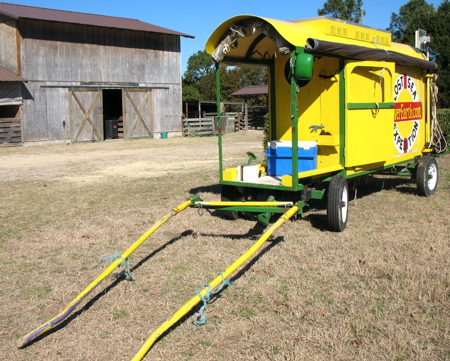
The Lost Sea wagon
So I grabbed Jester and put him in the shafts. It looked like this.
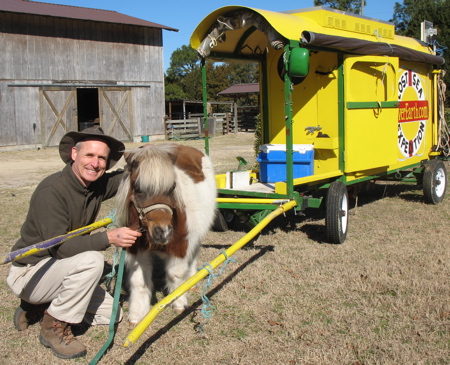
Clearly, imagination had over run common sense and the 1917 Army manual.
Jester pointed this out to me.

"bernie. this is a clear violation of the 1:1 rule"
Which raises the question. If a wagon dwarfs a miniature horse, then just what can the critter pull?
Easy. Just remember the RiverEarth 1:1 rule. This rule scales almost as well for half-ton draft animals as it does for miniature horses that weigh 200 pounds. Okay, so you won't be able to drive a mini 25 miles per day. But hitched to a light two-wheeled cart, you can expect a fit pony to pull its own weight (and then some) 10 to 15 miles per day - a very practical distance.
That's why, when friends and I hit the road to listen to bluegrass, my view from the Lost Sea wagon looks like this.
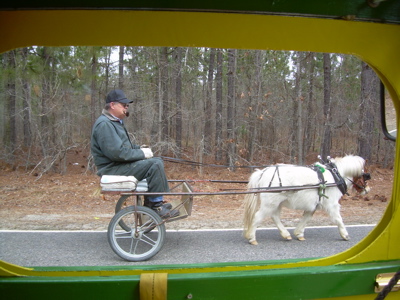
Vic's 15 mile-per-day rig as viewed from the Lost Sea wagon
Enjoy.
posted
by Bernie at 10:35 AM
|

